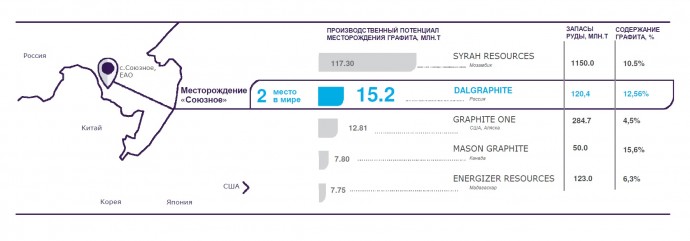Graphite is an environmentally friendly material with unique properties, which is needed in many current and future hi-tech applications. It has a constant annual growth rate (estimated 5%) and due to its economic importance combined with the current supply concentrated on China it is considered asStrategic Mineral by the EU and the USA.
Perspective properties of graphite
- High thermal shock resistivity
- Heat resistant above 3000 °C (without oxygen)
- No melting under normal pressure but sublimation at 3.652 °C
- Oxidation starts at about 500 °C to 600 °C
- Excellent thermal and electrical conductor
- Other molecules may be intercalated between graphene layers
- Energy storage abilities (Lithium-Ion-Batteries)
- Very good natural lubricant due to weak bondings between individual layers
- Intercalated (expanded) graphite excellent adsorbent for oil products
- Only strong oxidizing acids and halogens (F, Cl, Br, J) attack graphite, otherwise it is very resistant against corrosion
- Soft and flexible
- Gray, black steel color, fine black (pencil)
- Non- toxic, chemically inert
Applications of graphite
Due its unique properties, Graphite is used in many different applications.
Refractory
Refractory application is the biggest consumer of flake graphite, it is estimated that refractories consumes roughly half of the output of natural graphite. The heat resistance of graphite combined with high thermal shock rest resistivity is amongst other properties the key for the usage in graphite for refractories.
Special Industries
Natural graphite is also consumed in specialized industries where one or several of the characteristics of graphite are needed:
- Carbon brushes
- Friction materials like Brake pads
- Powder metallurgy
- Foundries
- Pencils
- Sealing Industry
Lubricants
For high temperature lubricants graphite is the main ingredient, especially in hot metal forming processes:
- Graphite based lubricants for forging
- Graphite based lubricants for heavy loaded friction joints
- Graphite based lubricants for motor industry
- Graphite based lubricants for seamless tube mills
Batteries / Energy systems
Two main characteristics of graphite are outstanding electrical conductivity as well as the ability to store (intercalate) molecules between the individual graphene layers. These properties are used for important energy applications:
- Alkaline-Manganese Batteries
- Lithium-Ion / Lithium-polymer batteries
- Fuel Cells
Graphite in compounds
Graphite is also used as an additive to polymers to achieve special properties, like antistatic behavior of plastics. Two main applications are:
- Graphite as antistatic or conductive additive
- Graphite as IR-blocker in insulation material
Graphite is one of the allotropicforms of Carbon, which is the 6th element of the periodic table ofthe elements. The other natural allotropic form of Carbon is Diamond, the mostimportant artificial forms are Graphenes, Fullerenes and Nanotubes.
The mineral Graphite was named by Abraham Gottlob Werner in 1789 from the Greek word “grafein” meaning “to write”. Usually it isformed by a process of metamorphism out of initially organic carbonic material,seldom it is formed by hydrothermal or other geological processes.

Types of Graphite
Natural graphite can be dividedin three forms:
- Crystalline flake graphite occurs as disseminated, flat, plate-like particles. Flake graphite is always disseminated in a host rock and needs therefore enrichment (flotation) for commercial use. Flake graphite can be found in several deposits around the globe. It has a very wide range of industrial applications which are described further down.
- Amorphous graphite consists of small graphite particles build out of micro or even nano-sized crystallites. Amorphous graphite is usually associated with coal deposits and can be found around the globe. The typical application for amorphous graphite is metallurgy.
- Vein graphite is hydrothermal in origin and occurs in fractures of rocks with vein width from 0 to some dozen cm. The graphite is very pure with an in situ carbon content up to >99%. It is, like the flake graphite, a highly crystalline form of carbon. The vein type of graphite is rather seldom, the only commercial mining operations are presently in Sri Lanka, the output is low. Applications are e.g. carbon brushes.

